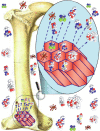Mesoporous bioactive glasses: structure characteristics, drug/growth factor delivery and bone regeneration application
- PMID: 23741607
- PMCID: PMC3363021
- DOI: 10.1098/rsfs.2011.0121
Mesoporous bioactive glasses: structure characteristics, drug/growth factor delivery and bone regeneration application
Abstract
The impact of bone diseases and trauma in the whole world has increased significantly in the past decades. Bioactive glasses are regarded as an important bone regeneration material owing to their generally excellent osteoconductivity and osteostimulativity. A new class of bioactive glass, referred to as mesoporous bioglass (MBG), was developed 7 years ago, which possess a highly ordered mesoporous channel structure and a highly specific surface area. The study of MBG for drug/growth factor delivery and bone tissue engineering has grown significantly in the past several years. In this article, we review the recent advances of MBG materials, including the preparation of different forms of MBG, composition-structure relationship, efficient drug/growth factor delivery and bone tissue engineering application. By summarizing our recent research, the interaction of MBG scaffolds with bone-forming cells, the effect of drug/growth factor delivery on proliferation and differentiation of tissue cells and the in vivo osteogenesis of MBG scaffolds are highlighted. The advantages and limitations of MBG for drug delivery and bone tissue engineering have been compared with microsize bioactive glasses and nanosize bioactive glasses. The future perspective of MBG is discussed for bone regeneration application by combining drug delivery with bone tissue engineering and investigating the in vivo osteogenesis mechanism in large animal models.
Keywords: bioactivity; bone tissue engineering; drug/growth factor delivery; mesoporous bioglass scaffolds; osteogenesis.
Figures










Similar articles
-
Mesoporous bioactive glasses as drug delivery and bone tissue regeneration platforms.Ther Deliv. 2011 Sep;2(9):1189-98. doi: 10.4155/tde.11.84. Ther Deliv. 2011. PMID: 22833912 Review.
-
Mesoporous bioactive glasses for bone healing and biomolecules delivery.Mater Sci Eng C Mater Biol Appl. 2020 Jan;106:110180. doi: 10.1016/j.msec.2019.110180. Epub 2019 Sep 10. Mater Sci Eng C Mater Biol Appl. 2020. PMID: 31753410 Review.
-
Delivery of dimethyloxallyl glycine in mesoporous bioactive glass scaffolds to improve angiogenesis and osteogenesis of human bone marrow stromal cells.Acta Biomater. 2013 Nov;9(11):9159-68. doi: 10.1016/j.actbio.2013.06.026. Epub 2013 Jun 26. Acta Biomater. 2013. PMID: 23811216
-
Biomimetic component coating on 3D scaffolds using high bioactivity of mesoporous bioactive ceramics.Int J Nanomedicine. 2011;6:2521-31. doi: 10.2147/IJN.S25647. Epub 2011 Oct 21. Int J Nanomedicine. 2011. PMID: 22072886 Free PMC article.
-
Europium-Containing Mesoporous Bioactive Glass Scaffolds for Stimulating in Vitro and in Vivo Osteogenesis.ACS Appl Mater Interfaces. 2016 May 11;8(18):11342-54. doi: 10.1021/acsami.6b03100. Epub 2016 Apr 29. ACS Appl Mater Interfaces. 2016. PMID: 27096527
Cited by
-
Dual drug delivery platforms for bone tissue engineering.Front Bioeng Biotechnol. 2022 Sep 12;10:969843. doi: 10.3389/fbioe.2022.969843. eCollection 2022. Front Bioeng Biotechnol. 2022. PMID: 36172012 Free PMC article. Review.
-
Achievements in Mesoporous Bioactive Glasses for Biomedical Applications.Pharmaceutics. 2022 Nov 29;14(12):2636. doi: 10.3390/pharmaceutics14122636. Pharmaceutics. 2022. PMID: 36559130 Free PMC article. Review.
-
Encapsulation of Anti-Tuberculosis Drugs within Mesoporous Silica and Intracellular Antibacterial Activities.Nanomaterials (Basel). 2014 Sep 11;4(3):813-826. doi: 10.3390/nano4030813. Nanomaterials (Basel). 2014. PMID: 28344250 Free PMC article.
-
Bioactive mono-dispersed nanospheres with long-term antibacterial effects for endodontic sealing.J Mater Chem B. 2017;5(6):1195-1204. doi: 10.1039/C6TB02819E. Epub 2017 Jan 5. J Mater Chem B. 2017. PMID: 28944058 Free PMC article.
-
Additive Manufacturing of Bioactive Glass and Its Polymer Composites as Bone Tissue Engineering Scaffolds: A Review.Bioengineering (Basel). 2023 Jun 1;10(6):672. doi: 10.3390/bioengineering10060672. Bioengineering (Basel). 2023. PMID: 37370603 Free PMC article. Review.
References
-
- Misra S. K., et al. 2010. Effect of nanoparticulate bioactive glass particles on bioactivity and cytocompatibility of poly(3-hydroxybutyrate) composites. J. R. Soc. Interface 7, 453–46510.1098/rsif.2009.0255 (doi:10.1098/rsif.2009.0255) - DOI - DOI - PMC - PubMed
-
- Hench L. L., Thompson I. 2010. Twenty-first century challenges for biomaterials. J. R. Soc. Interface 7(Suppl 4), S379–S39110.1098/rsif.2010.0151.focus (doi:10.1098/rsif.2010.0151.focus) - DOI - DOI - PMC - PubMed
-
- Chen Q. Z., Thompson I. D., Boccaccini A. R. 2006. 45S5 Bioglass-derived glass–ceramic scaffolds for bone tissue engineering. Biomaterials 27, 2414–242510.1016/j.biomaterials.2005.11.025 (doi:10.1016/j.biomaterials.2005.11.025) - DOI - DOI - PubMed
-
- Jones J. R., Tsigkou O., Coates E. E., Stevens M. M., Polak J. M., Hench L. L. 2007. Extracellular matrix formation and mineralization on a phosphate-free porous bioactive glass scaffold using primary human osteoblast (HOB) cells. Biomaterials 28, 1653–166310.1016/j.biomaterials.2006.11.022 (doi:10.1016/j.biomaterials.2006.11.022) - DOI - DOI - PubMed
-
- Jones J. R., Ehrenfried L. M., Hench L. L. 2006. Optimising bioactive glass scaffolds for bone tissue engineering. Biomaterials 27, 964–97310.1016/j.biomaterials.2005.07.017 (doi:10.1016/j.biomaterials.2005.07.017) - DOI - DOI - PubMed
LinkOut - more resources
Full Text Sources
Miscellaneous

